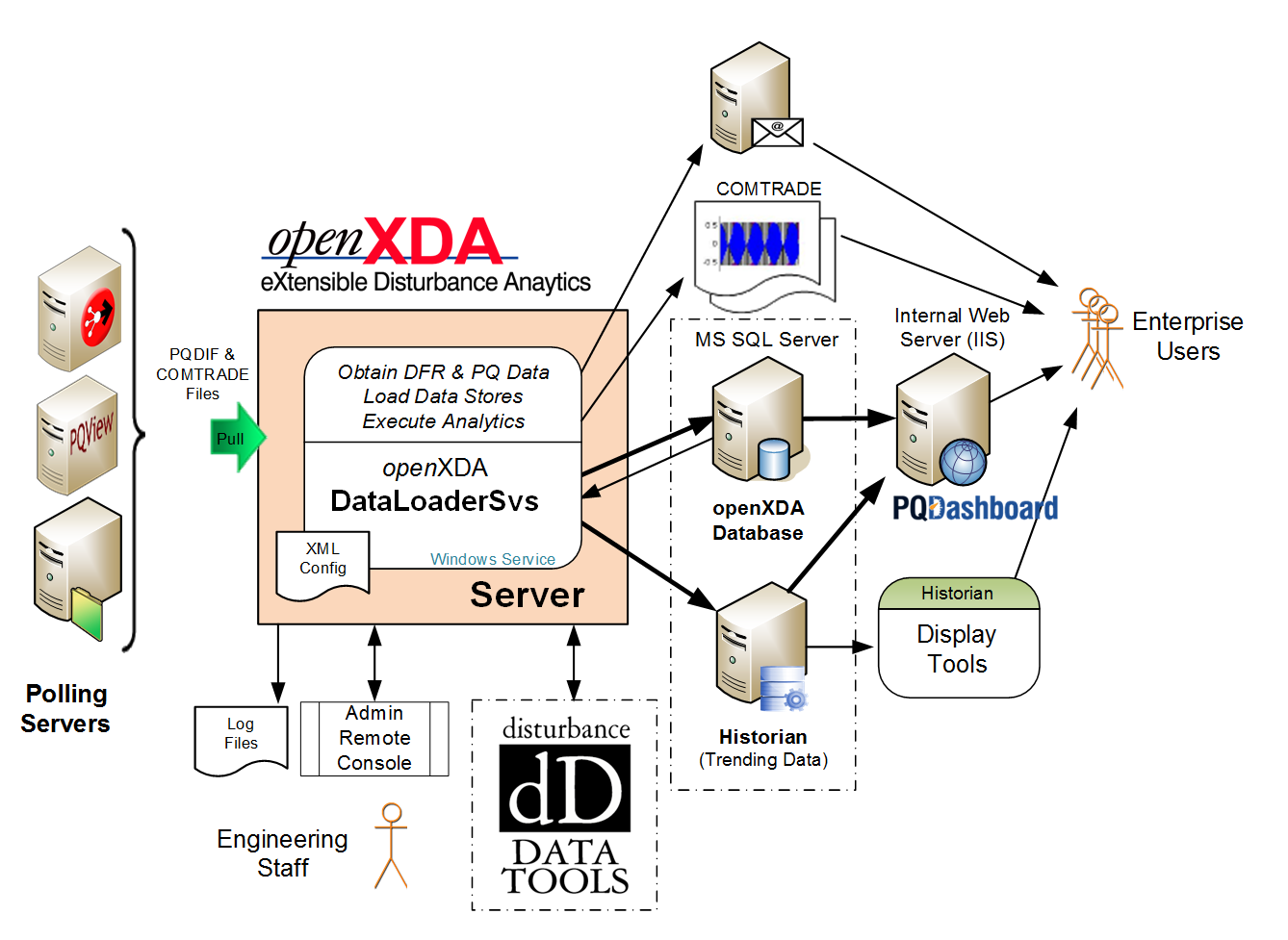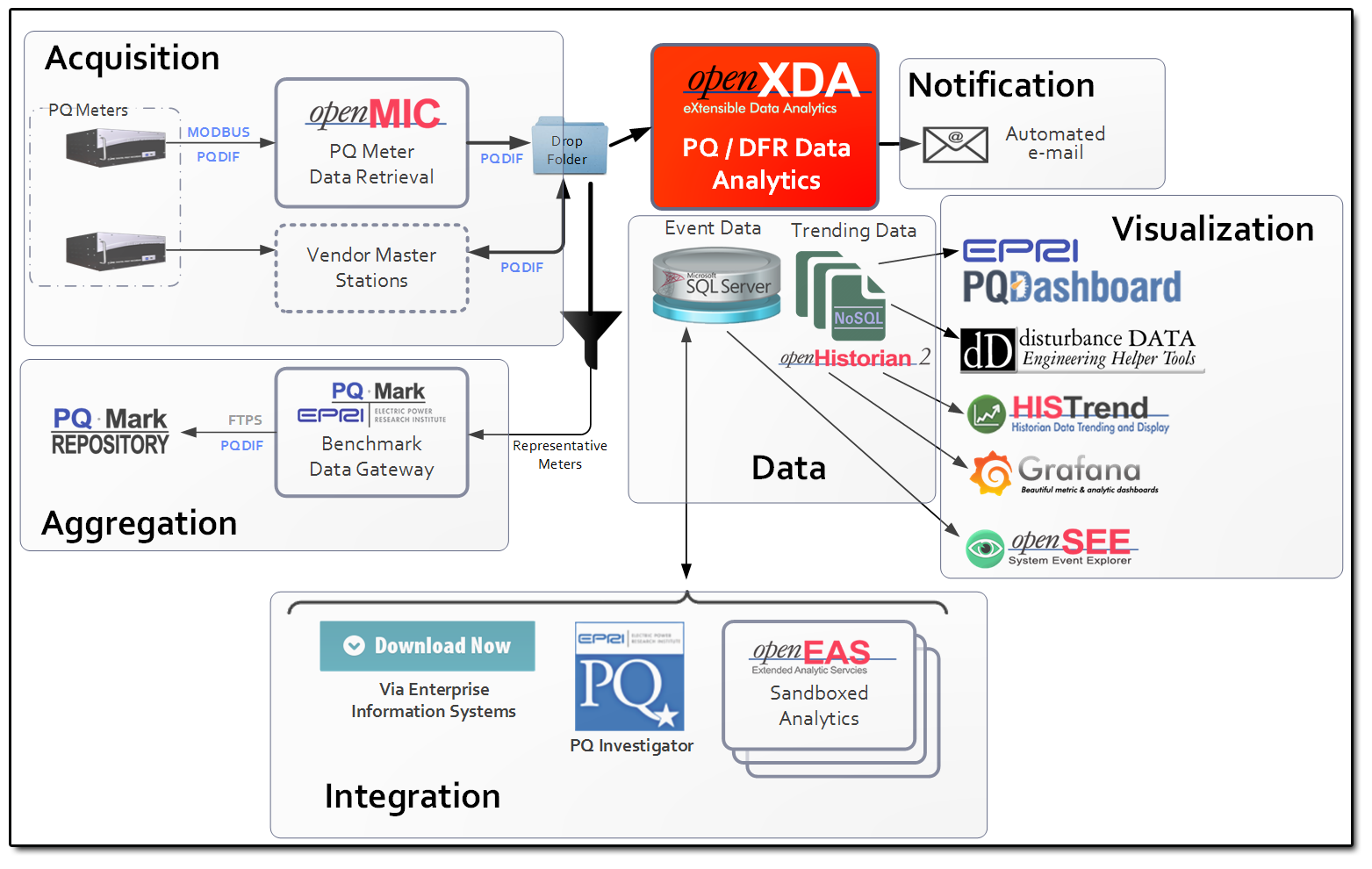eXtensible Disturbance Analytics
openXDA is an extension of work conducted in 2012 on openFLE for the Electric Power Research Institute (EPRI) which is posted under the project EPRIopenFLE.codeplex.com. The openFLE project included an open source C# parser for PQDIF formatted power quality files (IEEE 1159.3-2003).
openXDA continues to be expanded through active projects and forms the data layer for the 2014 EPRI project PQ Dashboard v1.0.3.
openXDA is an extensible platform for processing event and trending records from disturbance monitoring equipment such as digital fault recorders (DFRs), relays, power quality meters, and other power system IEDs. It includes a parser for COMTRADE, PQDIF, or E-max native formatted records, and demonstrations have been conducted using Schweitzer Engineering Laboratories (SEL) .eve files. Additional input formats are under development. openXDA can be used as a data integration layer and can facilitate the development of automated analytic systems. openXDA has been deployed in a number of major US utilities to perform automated fault distance calculations based on disturbance waveform data combined with line parameters. openXDA determines the fault presence and fault type, and uses 6 different single ended fault distance calculation methods to determine the line-distance to the fault. Additionally, if data is present for locations identified at each end of a line, a double-ended distance calculation is performed. For more information see: The BIG Picture - Open Source Software (OSS) for Disturbance Analytic Systems, Advanced Automated Analytics Using OSS Tools Presentation, Advanced Automated Analytics using OSS Tools Paper and openFLE overview.
openXDA is a platform comprised of a back office service designed to consume all disturbance records that conform to any of the developed input formats, and a configuration manager that controls the operation of the service and the automated analytics. A graphical user interface (GUI) is provided to configure the openXDA database and the openXDA service.
- The openXDA service
- Automatically discovers input data files.
- Parses files into timestamp-value sets.
- Calculates frequency domain values.
- True RMS voltage and current magnitudes.
- Sine wave curve fit to determine phase angles.
- Determines fault presence.
- Calculates fault type and fault distance.
- Populates results folder and/or SQL Server database.
- Stores trending values in openHistorian
- Emails results to selected users.
- The openXDA Manager
- Configures the openXDA service.
- Get Event Data
- Reliably frees developers from the chore of parsing and positioning event data for analysis.
- Automatically converts time domain data from IEDs into frequency domain values.
- Perform Calculations
- Determines event type
- Performs distance to fault calculations
- Sends email notifications
- Logs trending data alarm excursions
- openXDA can be easily extended with new distance algorithms.
- Additional analytics can be included as new modules in the platform.
Traditional disturbance analytic processes typically require manual retrieval of the data from a variety of substation devices, and a thorough knowledge of many different proprietary vendor software packages. Ultimately, the process requires a significant investment of staff time to retrieve, analyze, and notify, or publish results of the analysis. openXDA provides a platform that is designed for easy extension and integration into existing data processes to facilitate the development and deployment of fully automated analysis systems. An example system could produce automated fault recognition, type determination, and distance to fault calculations to be included in notifications, emails, or an event database. Systems built on the openXDA platform can produce analytic results as quickly as files can be retrieved from the remote devices. For installations where multiple substation devices are being used, openMIC can be used to expedite and simplify remote data retrieval. The openXDA platform is suitable for developing systems to automatically perform any analysis that is appropriate for data contained in disturbance records from IEDs.
- Documentation for openXDA can be found on the openXDA wiki.
- Documentation on all GPA products can be found on the GPA wiki.
- Get in contact with our development team on our new discussion boards.
Instructions on how to deploy openXDA can be found in the openXDA wiki
If you would like to contribute please:
- Read the Coding Style Guidelines.
- Fork the repository.
- Work your magic.
- Create a pull request.



